Zastrow.cuirassier
PlanetFigure Supporter
A bad operation and the article is on Web, thus to continue with JOHN SMITH MODELLBAU News
Armoured Sentry 1917 (25SP)
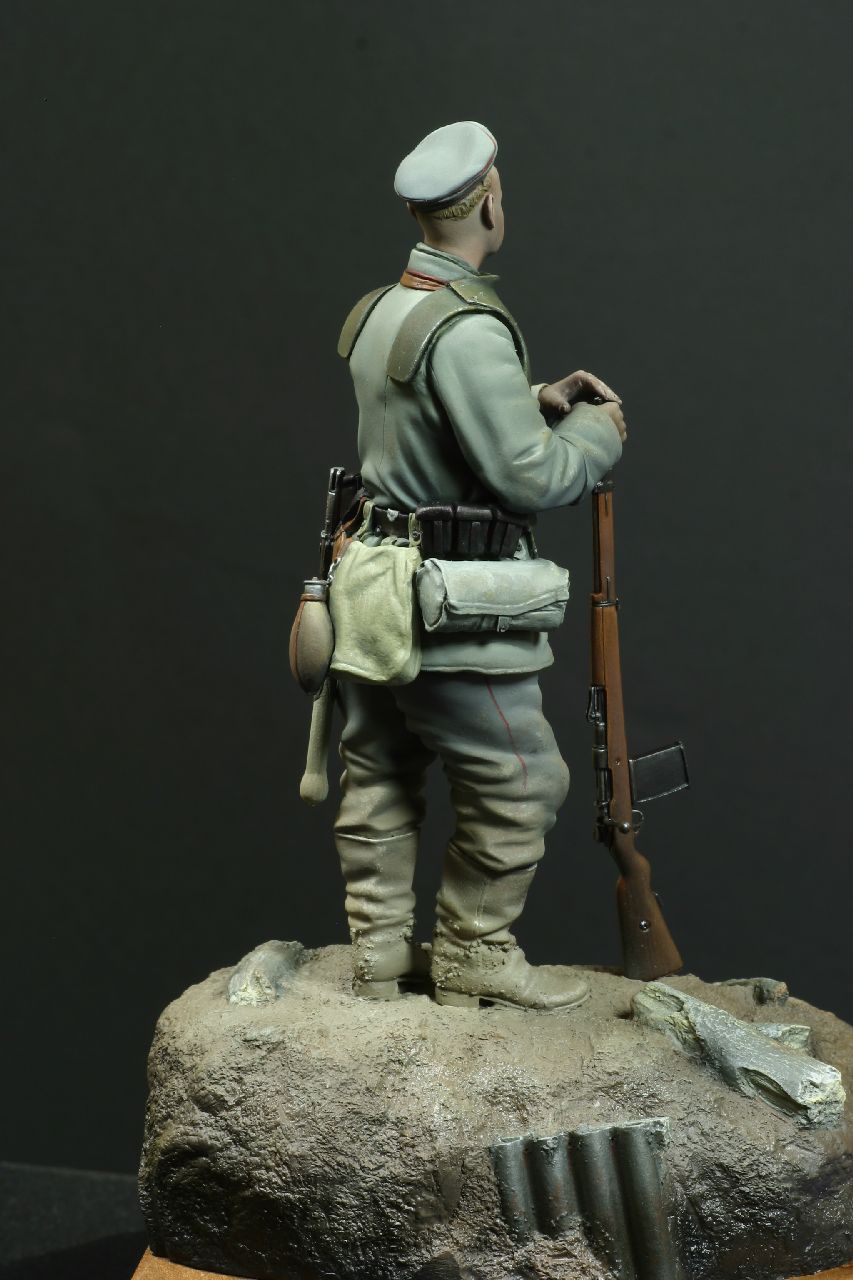
2 heads are included in the box, and the cast is quite perfect :
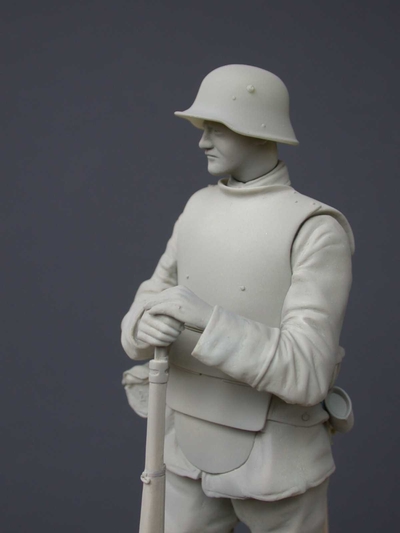
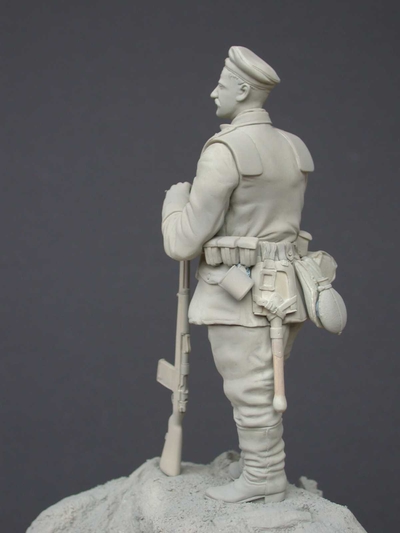
German Sentry, Infantryman, Western Front 1917
The figure depicts a German Infantryman on duty in the Front Line area during the winter 1917/18. He wears the armoured plate body armour associated with troops on guard duty, snipers or MG personnel within exposed areas of the Front.
The German Soldier of 1917 and 1918. The German soldier in 1917/18 had changed somewhat from his comrades of 1914. Firstly, he would have been much younger – on average about 18/19 years of age after finishing training – NCOs a year or two older. The style of his uniform differed not only in quality but function as well, with many items of clothing and equipment produced in Ersatz material, or a combination of mixed dress. Infantry Companies within the Front Line areas numbered on averaged 75 – 80 soldiers, some as low as 50 (a full Company strength would be around 135 men), with the bulk of its fighting capacity and experience held by only 15 – 20 old sweats. As the war progressed more emphasis was put onto automatic weapons and as many as 4 MG 08/15s per Infantry Company were to be found.
Steel Body Armour: Grabenpanzer or Sappenpanzer. Devised by the German Army and introduced in 1916 for protection against light infantry weapons and shrapnel. This special nickel/silicon steel body armour, or trench armour was issued to partially exposed troops such as snipers, MG troops and sentries within the Front Line areas.
The armor consisted of a breastplate, with 3 overlapping protective sections for the stomach and groin. 2 shoulder plates fixed with 3 rivets on each side held the armour over the body. The individual plates were connected with 2 webbing straps fastened onto the inside of the armour starting on the breast section where the two rivets are situated. Rectangular horsehair felt pads were stitched to the webbing strap to lay in-between the sections and reduce noise when the wearer moved (the pads can be seen protruding under the plates on original photos and the model figure). The thickness of armour was approx. 3.25 mm with a 25mm overlap of the plates. Measurements would of cause differ from one set of armour to the next, there being at least 7 manufactures involved in production.
The armour was issued in different models, but basically 2 types can be discovered when searching for photos or original items. The first is the plain / first issue type (worn by this figure). The second model has 2 additional equipment support hooks on the main breast plate, along with a rifle bracket welded to the top area and attachment slits for securing a strap to go around the body and hold the armour in place. The weight, depending on the manufacture was between 8 and 10 Kg and appears to of been issued in either 2 or 3 different sizes.
Sources claim that between 400,000 and 500,000 were produced and is one of the most sought after items for any WW1 collector today. Considering how many were supposedly manufactured, there are not many around.
Colour: Judging by the few original items in museums and private collectors the factory colour is olive green. Horsehair pads: a light grey / brown.
Ammunition Pouches M1909: Patronentaschen M1909. These ammunition pouches belonged to the standard equipment of the infantryman. Each comprised 3 smaller pouches mounted on a stiffened backing fastened with a strap held down by a small brass button (from January 1915 galvanized steel). Each pouch held 4 strips of 5 rounds, giving a total of 120 rounds per man. Colour: Army regulation September 1915 stated that all leather equipment was to be issued blackened.
Metal Cup M1916: Tasse M1916. The enamelled steel cup replaced the earlier aluminium version (production was discontinued in October 1914 due to lack of aluminium) and can be fixed to one of the bread bag fastening straps. The opposite end to the handle is a small indent in the rim to allow the cup to be used as a small jug. The official place for this cup was inside the bread bag. Colour: light olive green / field-grey.
I have seen various photos of this item being fixed to the bread bag fastening strap above the water bottle – the handle may need to be cut open, depending on where it is fixed.
Mauser Rifle 98: Gewehr 98. The G98 derived from the less successful Gewehr 88 and became the standard German infantry rifle of the WW1. It had an overall length of 125 cm (49.25 inch) and used the 7.92 mm round. It was a good rifle – well made, generally soldier proof and accurate at long ranges. Some of the first models were purchased by the Boers, who used them with great effect against the British in South Africa. Compared with the British Short Magazine Lee Enfield, the G98 had certain drawbacks. Even in experienced hands it could never keep up with the rate of fire of the British SMLE. A British infantryman could fire 15 aimed shots at 300 yards per minute and with some more experienced men managing 25-30 in the so called `mad minute´. Also, the length of the G98, especially when fixed with a bayonet was far too long in the confined spaces of the trenches. A further disadvantage was that the bolt handle stuck out at a 90°angle to the rifle, causing it to sometimes snag on uniform and equipment. On the right hand side of the butt there is the small metal disc where the unit identification was stamped. On the right hand side, at the end of the stock are the 2 metal locking splints used to dissemble the rifle. The cleaning rod seen under barrel was only approx. 30 cm long and had to be screwed together using 2 other rods from comrade’s rifles. Without the cleaning rod the rifle could not be stacked in 3s in the typical pyramid fashion of the day (particularly seen with German troops). Colour: wood – brown. Metal – dark metal.
On the plaster base an indent has been made for the positioning of the rifle butt (in front of the figure’s feet).
Trench Magazine: Ansteckmagazin (the designation Grabenmagazin or trench magazine was never used in the German Army, but has become the more common name now used for this item).
This 25 round `trench´ magazine or Mehrlader was developed to increase the rate of fire and was permanently fixed to the rifle (it was not possible to load the magazine when detached from the rifle). Manufacturing of the magazines began in October 1915 with the intention that every soldier at the Front should receive one. It was constructed from sheet steel and fed from the top of the weapon with clips of rounds. The small slide attached by a chain to the side of the magazine body would be placed into a slit at the top to avoid the magazine feed slide and spring from escaping whilst unattached (when not in use this would slip into the bracket at bottom as shown on this model).
There were not only advantages with the 25 round capacity – it suffered problems due to over-strength of the spring and was generally unwieldy in trench use. Also, the rifle could not be fired easily when resting on a trench parapet or in the prone (laying down) position. Colour: many of the original items show traces of dark grey or black paint.
When the rifle is position as on this figure, then the chain should hang down as shown. The fitting plug on the rifle can be removed and sanded down if wished, showing the G98 without the magazine.
The only default from JOHN SMITH MODELLBAU is Little of novelties proposed, it's a pity, they are among the most beautiful figurines 54mm and 120mm on the subject.
Other new figure :
German NCO Veteran, Western Front 1917/18 (Code: 27AH)
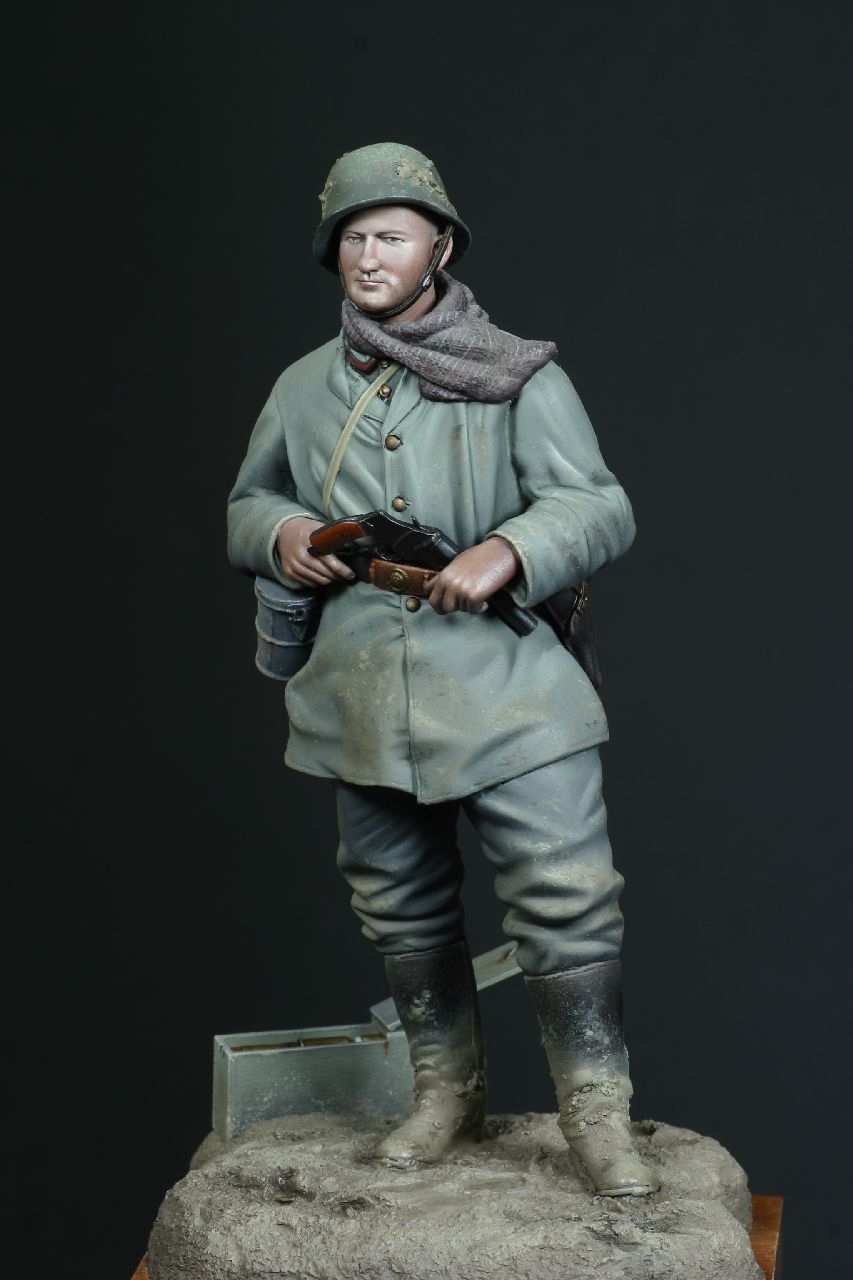
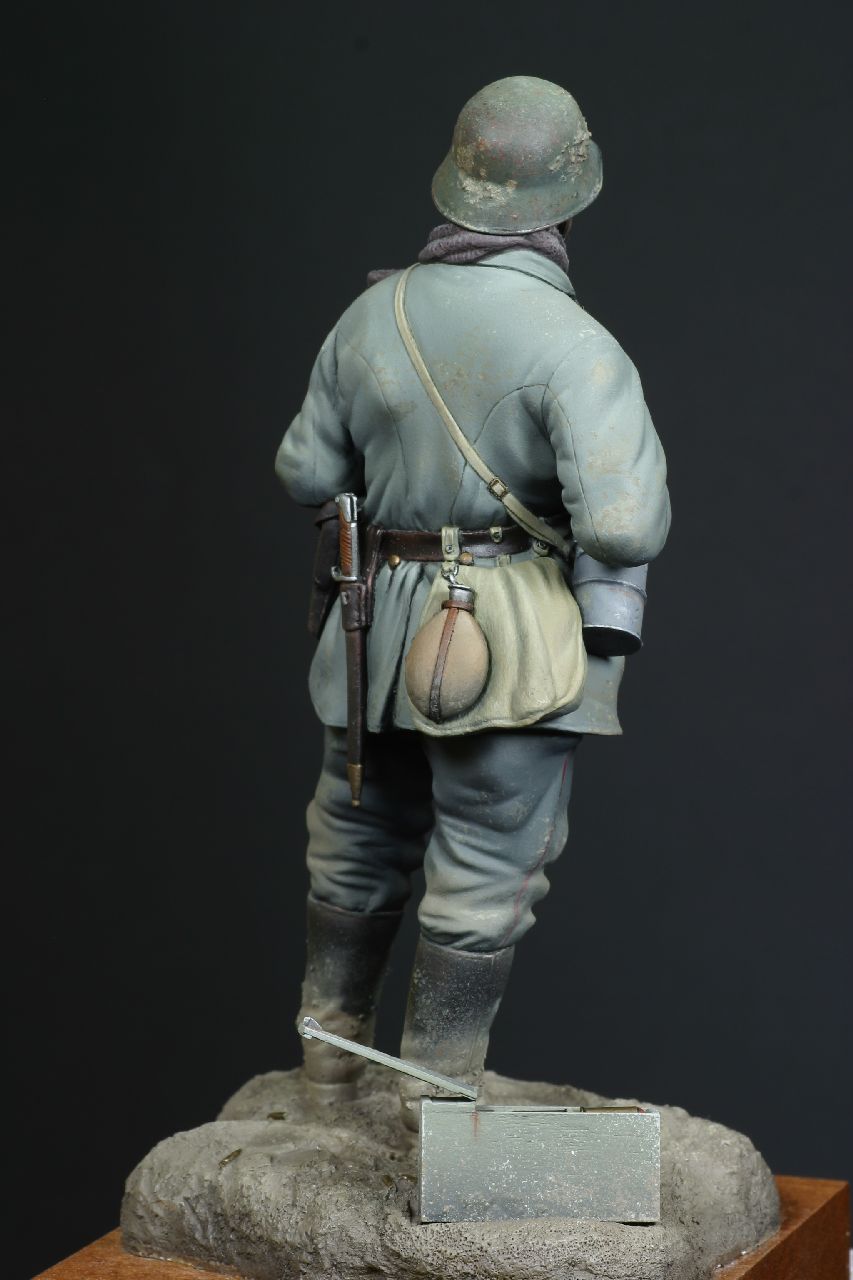
Also 2 heads provided :
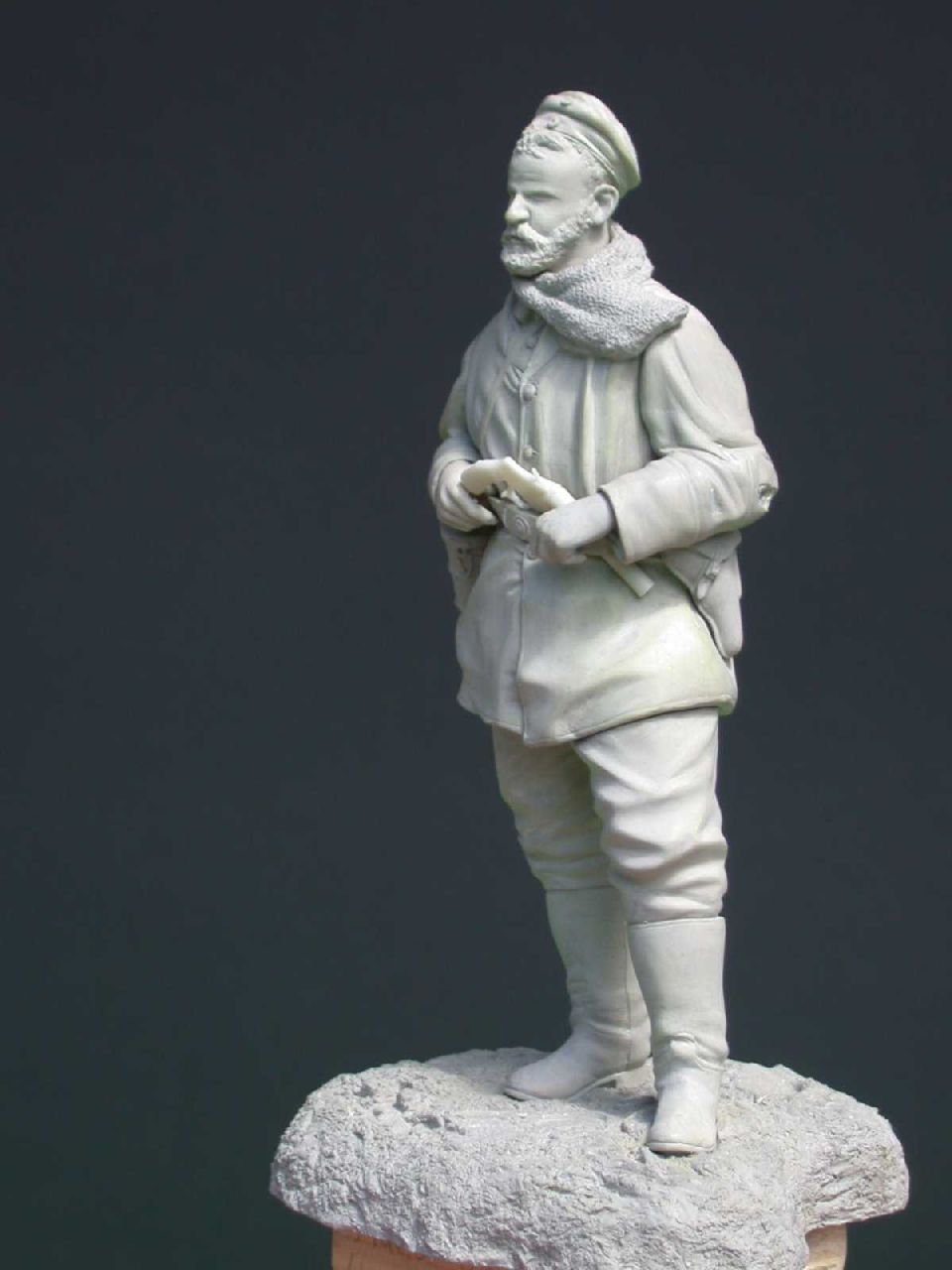 To order is very easy, go on the website :jonsmith-modellbau.com
To order is very easy, go on the website :jonsmith-modellbau.com
and after choose what you want to order , and send a message to the owner via :
[email protected]
Armoured Sentry 1917 (25SP)

2 heads are included in the box, and the cast is quite perfect :


German Sentry, Infantryman, Western Front 1917
- Scale / Maßstab: 1:15 / 120mm
- Material: Resin (model plaster base)
- Parts / Teile: 25
- Infosheet / Infoblatt: English
- Code: 25SP
- Weight / Gewicht: 355 g
- Price / Preis: 45.00 EUR
- Figure (8 parts)
- Alternative Head (for helmet)
- Ammunition Pouches M1909 – Patronentaschen M1909
- Water Bottle – Feldflasche M1907
- Haversack – Brotbeutel M1887
- Canvas Gas Mask Holder – Segeltuchtasche für Gasmaske
- Metal Cup M1916 – Tasse M1916
- Spade M1887 – Spaten M1887
- Bayonet M1898/1905 – Seitengewehr M1898/1905
- Mauser Rifle 98 – Gewehr 98
- Trench Magazine – Ansteckmagazin (Grabenmagazin)
- Steel Helmet – Stahlhelm M.16
- Large Figure Base
The figure depicts a German Infantryman on duty in the Front Line area during the winter 1917/18. He wears the armoured plate body armour associated with troops on guard duty, snipers or MG personnel within exposed areas of the Front.
The German Soldier of 1917 and 1918. The German soldier in 1917/18 had changed somewhat from his comrades of 1914. Firstly, he would have been much younger – on average about 18/19 years of age after finishing training – NCOs a year or two older. The style of his uniform differed not only in quality but function as well, with many items of clothing and equipment produced in Ersatz material, or a combination of mixed dress. Infantry Companies within the Front Line areas numbered on averaged 75 – 80 soldiers, some as low as 50 (a full Company strength would be around 135 men), with the bulk of its fighting capacity and experience held by only 15 – 20 old sweats. As the war progressed more emphasis was put onto automatic weapons and as many as 4 MG 08/15s per Infantry Company were to be found.
Steel Body Armour: Grabenpanzer or Sappenpanzer. Devised by the German Army and introduced in 1916 for protection against light infantry weapons and shrapnel. This special nickel/silicon steel body armour, or trench armour was issued to partially exposed troops such as snipers, MG troops and sentries within the Front Line areas.
The armor consisted of a breastplate, with 3 overlapping protective sections for the stomach and groin. 2 shoulder plates fixed with 3 rivets on each side held the armour over the body. The individual plates were connected with 2 webbing straps fastened onto the inside of the armour starting on the breast section where the two rivets are situated. Rectangular horsehair felt pads were stitched to the webbing strap to lay in-between the sections and reduce noise when the wearer moved (the pads can be seen protruding under the plates on original photos and the model figure). The thickness of armour was approx. 3.25 mm with a 25mm overlap of the plates. Measurements would of cause differ from one set of armour to the next, there being at least 7 manufactures involved in production.
The armour was issued in different models, but basically 2 types can be discovered when searching for photos or original items. The first is the plain / first issue type (worn by this figure). The second model has 2 additional equipment support hooks on the main breast plate, along with a rifle bracket welded to the top area and attachment slits for securing a strap to go around the body and hold the armour in place. The weight, depending on the manufacture was between 8 and 10 Kg and appears to of been issued in either 2 or 3 different sizes.
Sources claim that between 400,000 and 500,000 were produced and is one of the most sought after items for any WW1 collector today. Considering how many were supposedly manufactured, there are not many around.
Colour: Judging by the few original items in museums and private collectors the factory colour is olive green. Horsehair pads: a light grey / brown.
Ammunition Pouches M1909: Patronentaschen M1909. These ammunition pouches belonged to the standard equipment of the infantryman. Each comprised 3 smaller pouches mounted on a stiffened backing fastened with a strap held down by a small brass button (from January 1915 galvanized steel). Each pouch held 4 strips of 5 rounds, giving a total of 120 rounds per man. Colour: Army regulation September 1915 stated that all leather equipment was to be issued blackened.
Metal Cup M1916: Tasse M1916. The enamelled steel cup replaced the earlier aluminium version (production was discontinued in October 1914 due to lack of aluminium) and can be fixed to one of the bread bag fastening straps. The opposite end to the handle is a small indent in the rim to allow the cup to be used as a small jug. The official place for this cup was inside the bread bag. Colour: light olive green / field-grey.
I have seen various photos of this item being fixed to the bread bag fastening strap above the water bottle – the handle may need to be cut open, depending on where it is fixed.
Mauser Rifle 98: Gewehr 98. The G98 derived from the less successful Gewehr 88 and became the standard German infantry rifle of the WW1. It had an overall length of 125 cm (49.25 inch) and used the 7.92 mm round. It was a good rifle – well made, generally soldier proof and accurate at long ranges. Some of the first models were purchased by the Boers, who used them with great effect against the British in South Africa. Compared with the British Short Magazine Lee Enfield, the G98 had certain drawbacks. Even in experienced hands it could never keep up with the rate of fire of the British SMLE. A British infantryman could fire 15 aimed shots at 300 yards per minute and with some more experienced men managing 25-30 in the so called `mad minute´. Also, the length of the G98, especially when fixed with a bayonet was far too long in the confined spaces of the trenches. A further disadvantage was that the bolt handle stuck out at a 90°angle to the rifle, causing it to sometimes snag on uniform and equipment. On the right hand side of the butt there is the small metal disc where the unit identification was stamped. On the right hand side, at the end of the stock are the 2 metal locking splints used to dissemble the rifle. The cleaning rod seen under barrel was only approx. 30 cm long and had to be screwed together using 2 other rods from comrade’s rifles. Without the cleaning rod the rifle could not be stacked in 3s in the typical pyramid fashion of the day (particularly seen with German troops). Colour: wood – brown. Metal – dark metal.
On the plaster base an indent has been made for the positioning of the rifle butt (in front of the figure’s feet).
Trench Magazine: Ansteckmagazin (the designation Grabenmagazin or trench magazine was never used in the German Army, but has become the more common name now used for this item).
This 25 round `trench´ magazine or Mehrlader was developed to increase the rate of fire and was permanently fixed to the rifle (it was not possible to load the magazine when detached from the rifle). Manufacturing of the magazines began in October 1915 with the intention that every soldier at the Front should receive one. It was constructed from sheet steel and fed from the top of the weapon with clips of rounds. The small slide attached by a chain to the side of the magazine body would be placed into a slit at the top to avoid the magazine feed slide and spring from escaping whilst unattached (when not in use this would slip into the bracket at bottom as shown on this model).
There were not only advantages with the 25 round capacity – it suffered problems due to over-strength of the spring and was generally unwieldy in trench use. Also, the rifle could not be fired easily when resting on a trench parapet or in the prone (laying down) position. Colour: many of the original items show traces of dark grey or black paint.
When the rifle is position as on this figure, then the chain should hang down as shown. The fitting plug on the rifle can be removed and sanded down if wished, showing the G98 without the magazine.
The only default from JOHN SMITH MODELLBAU is Little of novelties proposed, it's a pity, they are among the most beautiful figurines 54mm and 120mm on the subject.
Other new figure :
German NCO Veteran, Western Front 1917/18 (Code: 27AH)


Also 2 heads provided :

and after choose what you want to order , and send a message to the owner via :
[email protected]
